Coconut milk is a rockstar ingredient in Thai cooking, though using a good vs. bad one can mean the difference between a great dish and a not-so-good one.
So in this article you'll find answers to basically every question I've gotten about it over the years, plus everything you need to know; including how to choose, use, store and substitute it in your cooking.
If you're more of a video person, watch this video below where I go through all the basics, though there is more detailed information in the article.
Note: Since the shooting of this video, there have been some changes: Aroy-D UHT coconut milk is STILL my recommended brand, but it now includes a preservative. I have not found this to affect the taste of the product and don't see it as a problem.
What is Coconut Milk?
Coconut milk is the liquid that is pressed out of grated coconut flesh (aka coconut meat). Only mature coconuts (the brown hairy ones) are used for this, as young coconuts (the green ones you see on beaches) do not contain enough fat in their flesh.
If you want to know exactly how it gets made, here's a video of me making it from scratch using the traditional method!
What is the Difference Between Coconut Milk and Coconut Cream?
The presence of coconut cream can confuse people when they're shopping, but basically, coconut cream has a higher proportion of coconut oil; it is exactly the same as the difference between dairy milk and dairy cream.
In my Thai recipes though I never call for coconut cream, because it is not an ingredient that we traditionally use. (I don't even think you can buy it in Thailand!). This is because coconut cream is an industrial product made by artificially removing water from coconut milk, so it has no place in traditional Thai cooking.

Having said that, we do have two different levels of richness of coconut milk. The first press, called hua gati (literally the "head" of the coconut milk), and the second press, haang gati, or the "tail". Some people call the first press "cream" and the second "milk," but this is incorrect, and I'll explain.
The first press coconut milk is made with little or no water added for a rich and flavourful liquid. But so as not be wasteful, Thai people then take the already-used coconut meat, add more hot water to it, and press it again to get another round of coconut milk that is quite diluted, but still useful.
All store bought coconut milk is first press, and they do not sell the second press. This is why calling these "cream" and "milk" is misleading. Store bought coconut cream is even richer and fattier than the first press!
Can I Use Coconut Cream instead of Coconut Milk?
You technically can, but know that you'll end up with a much richer and fattier dish. If that's what you want, (maybe you're on a keto diet looking to get more healthy fat in your meals), then go for it.
In theory you could add water to coconut cream to make it "milk", but I don't know how much you would need to add, so you would have to experiment and maybe do some math to match the calorie count of your coconut cream with that of coconut milk!
You can also use coconut cream as a vegan substitute for heavy cream in any recipe if you're okay with the flavor.
Can I Use Light Coconut Milk Instead?
Light or lite coconut milk has a lower fat content. It also has more water added. See in the pictures below, the regular one has "coconut" listed as the first ingredient, followed by water, but the light coconut milk has water listed first. But because coconut fat is where the flavour is, the "light" is also light in flavour.
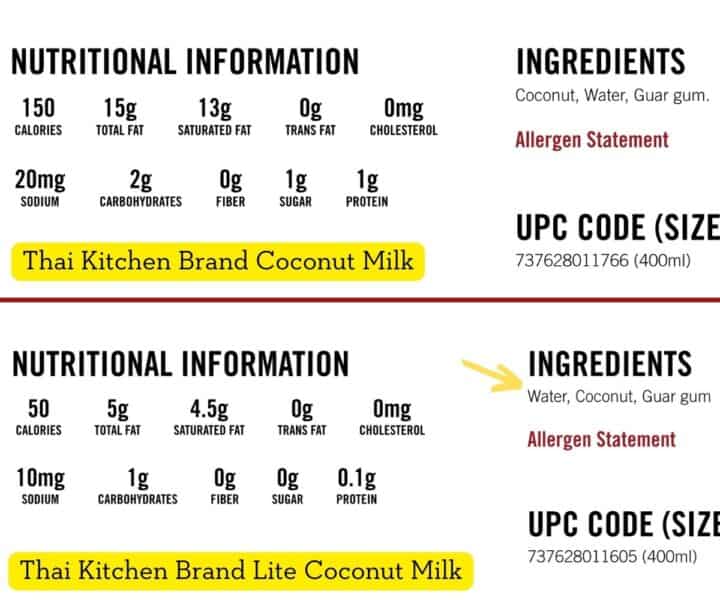
I do not recommend cooking with it because you're giving up a lot of flavour. If you want to cut down on calories (and are willing to give up some flavour) you can simply add a little less full-fat coconut milk, then add more water to makeup the volume. That's essentially what light coconut milk is, so you might as well save yourself some money!
Watch Out for Coconut Beverage
Trendy coffee shops now give you the option of using "coconut milk" in your lattes, but this is a misnomer and cause for confusion! What they're actually using is technically a coconut beverage, in the same way that "almond milk" is actually, technically, an "almond beverage."
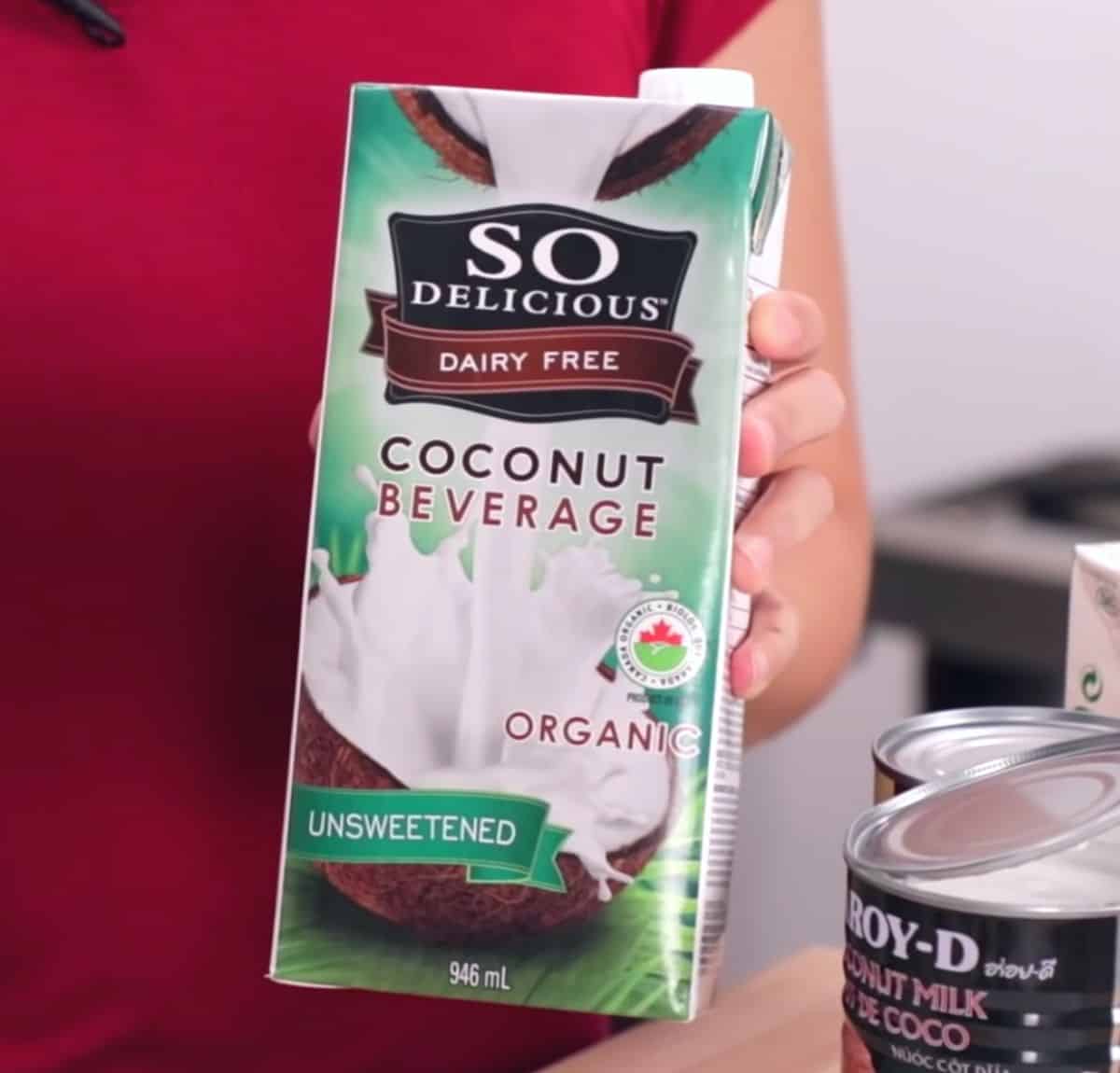
It is a milk substitute for vegans and people with lactose intolerance, and you cannot use it for cooking. Why? These have had most of the tasty coconut fat taken out in order to make it drinkable, so it is very thin and doesn't taste anything like coconut. It's the extreme version of light coconut milk discussed above.
What then...is Coconut Water?
A quick mention here to avoid confusion. Coconut water is a completely different ingredient and is not substitutable for coconut milk in any way. It is the almost-clear, sweet and tasty liquid inside of a coconut. It makes a great refreshing beverage, or dessert recipes such as these coconut water jelly fruit cubes!
What is the best coconut milk for cooking?
When I first came to Canada, I only had access to canned coconut milk, and I was less than enthralled by its flavour. But one day I found one in a paper carton, and lo and behold, smelling it brought back memories of Thailand. Much better! So first, let's talk about the kind of coconut milk you should get:
1. Choose UHT Cartons, if possible
When you're at the grocery store, look past all the cans and find the ones in paper cartons. Here's why:
Coconut milk in UHT cartons have been heat treated for a shorter amount of time, keeping more of the delicious flavour intact. Canned coconut milk has had aggressive heat treatment, and as a result doesn't taste as good. In Thailand most stores only carry the cartons, because it's better! But cans are preferred for export because they are more durable.
Save this recipe!
Now, that doesn't mean you should never use cans! If you're making savory dishes, the canned ones will be just fine because there's a lot of competing flavors, (a lot of herbs and spices), so you won't taste too much of a difference. But if you are making desserts, like this amazing Thai coconut ice cream, the difference will be obvious.
2. Choose one with the least ingredients.
Once you've looked for cartons, (and if you don't see them cans are fine), you should then choose the brand with the least number of other ingredients. Low quality coconut milk adds a lot of thickeners, such as gums to artificially create creaminess.
For example, in the pictures below, my top choice, Aroy-D, only contains coconut milk and a preservative (polysorbate 60). A cheaper one in a can contains: Water (as a first ingredient!), coconut extract, monoglycerides, guar gum, xanthan gum, polysorbate 60, and cellulose gum.

A note on guar gum: Many brands add guar gum to thicken and prevent the coconut milk fat from separating. While this doesn't affect the flavour, it does make the it artificially thicker, and is not my preference. It also prevents the fat from "breaking" which is something we do in traditional Thai curry making.
If you want to learn more about how coconut milk is produced at an industrial scale in Thailand, check out this fascinating short documentary that we filmed, tracking the journey of the coconut from the farm all the way to the cans!
What You Should Avoid
Assuming you're looking for coconut milk for cooking, you should avoid:
- Anything with multiple additives
- Anything powdered (unless you're going camping)
- Anything with "light", "lite", or "low-fat" on the label, as discussed above
- Anything with added sugars
- Anything with piña coladas on the package (so no Coco Lopez Cream of Coconut, thank you)
- Anything that sits on the plant-based beverages shelf
How to Use Coconut Milk
Southeast Asian cuisine does not use any dairy, so when we need things to be creamy, we turn to coconut milk. So aside from using it in traditional Thai recipes, it is a great way to add creamy texture in anything. Here are some ideas:
- Soups, stews, curries, sauces, and anything saucy and creamy
- Smoothies
- Salad dressings
- Puddings and porridges
- It is a great milk substitute in baking (though it does have a higher fat content)
- Put it in your coffee!
Coconut milk has about 13%-17% fat, depending on the brand, so keep that in mind if you're thinking of substituting it for dairy products in recipes.
Storage Tips
Once opened, keep coconut milk in the fridge and it should last you at least a week, but probably not more than 3. If you're not planning to use it soon, push it to the back of your fridge, where it's coldest (but don't forget about it!). You'll know it's gone bad if it has pink, green, or black mold on the edges.
Pro tip: If it's been sitting in your fridge for 2 weeks and you THINK it's gonna go bad any day now, bring it to a boil once and that will extend its shelf life!
You can freeze coconut milk; however, when it thaws, it becomes a little grainy and the texture is not the same. If you're going to use it in a curry, or a stir fry, it's fine. But not in desserts or when smoothness is required.
Why does my coconut milk separate and how to fix it?
If you go to open a can and you're surprised to discover a solid mass of white with watery stuff at the bottom...nothing has gone wrong. It's exactly as it should be.
Coconut milk is an oil-in-water emulsion, but a very unstable one. Without enough emulsifiers, over time coconut oil will separate from its watery component, rise to the top, and because it's mostly made up of saturated fat, it will solidify if the room is cool enough.
If this happens, all you need to do is warm it up a bit and stir everything together - problem solved.
Substitutes for coconut milk
I was completely shocked when someone told me he has had allergic reactions to coconut. WHAT? I thought coconut was the go-to solution to people with food allergies! Turns out, people can be allergic to coconut, and I have met more such individuals since.
Though there's no good substitute flavour-wise, we can at least go for texture. In savory dishes, where you've got a lot of other flavors going, you can go with either evaporated milk, a combination of milk and cream, or half and half.
I have had success making Thai curries using soy milk because the flavor of the curry paste is so strong that it didn't affect the end result too much; so other non-dairy milk alternatives like oat milk would probably work also. But choose one with the richest texture and highest fat content.
Nutritional Information
When I was a kid, Thai adults around me were talking about coconut milk as a "fattening" ingredient. Then all of a sudden Wholefoods is flooded with coconut products touting all sorts of magical health benefits. I'm not going too deep into it here as it's not my jam, but I get asked A LOT about the nutrition side of things, so here's what we know and what I think:
For a ⅓-cup or 80 ml serving (pretty reasonable amount IMO), Aroy-D coconut milk has 15 grams of fat, which is 20% of the Daily Value for an average person. The fat is responsible for most of its 150 calories, and it only has 1 gram of protein and 2 grams of carbs. So when thinking about your macros, treat it as a fat.
But most of the fats are medium-chain triglycerides, which have been a subject of much research about its potential value in weight loss, preventing heart disease, as well as lowering "bad" LDL cholesterol.
As of now, it seems to be at a "looks very promising but further studies are needed to confirm" stage, and you can read more on it in this great article here.
My take on it is this: coconut milk is a perfectly healthy, natural ingredient, and you should enjoy it like you do any other healthy foods. But it is not a low calorie food, so it's wise to keep an eye on the amount if you're watching your weight.
Need Recipe Ideas? Start with these!
Now that you know everything there is to know, it's time to start cooking! Here are some classic recipes that use coconut milk as a main ingredient.



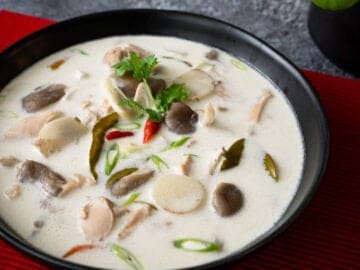
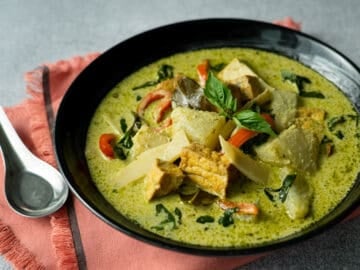
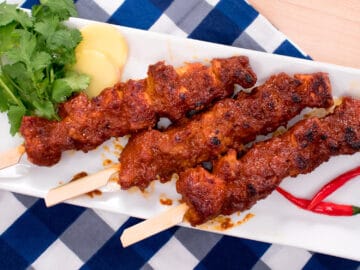


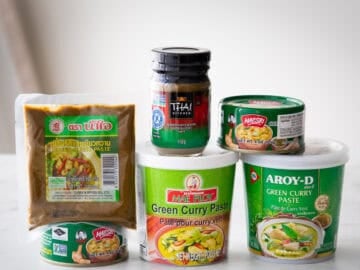
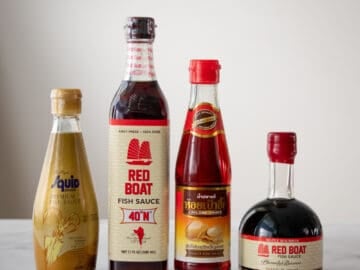

Elizabeth says
I was reading a reddit thread that says Aroy-d and Chaokoh coconut milk are picked by monkeys that are also poorly treated-- is this still the case? I have been buying Aroy-d b/c you recommended it. Please let me know what you think. Thanks. (BTW-- I lived in Thailand, briefly, in 2018).
hmijail says
It's so rare to find a recipe website that goes the extra mile to explain things while avoiding the silly detox "all chemicals are bad" stuff. Thank you lots, I'm bookmarking for when I need Thai references!
Mats Wichmann says
Particularly given your ingredient label pictures above, it's *possible* that some people who react badly to coconut milk are actually not allergic to coconut but to the preservatives in the milk - my partner reacts badly to all the various polysorbate compounds, some worse than others. This took a long time to settle in on because it's not one of the big-name allergens but now if there are polysorbates on the label, it's just a nogo. This is really insidious... better check the label on supermarket baked goods (cupcakes are a very frequent sinner); and cosmetic companies will, without warning, reformulate a lotion that we've used for years and put polysorbates in it as part of an "improvement", and the reaction causes a reread of the label... "oh, no, not them too!".
Mats Wichmann says
... sheesh, I forgot to add that we use Field Day brand specifically because it doesn't have polysorbates in it, and is a bit more economical than one other brand we see here that I won't mention, but I see now it does add the guar gum.
Teppo says
I prefer Grace, it is a bit richer than Aroy-D in my opinion. Also Kara is great, and it is readily available in all supermarkets here. Aroy-D and Grace are not that easy to find, and usually found only from shops that specifies in asian ingredients.
Pj Bell says
Thank you, this was a very informative video.
It certainly cleared all of my questions, very much appreciated.
Grampah Pete says
Thanks very much for taking the time for me, Khun Pai... I'm delighted to get this news!
Grampah Pete says
Khun Pai, about 55 years ago, I arrived on Koh Samui to teach English... Many of my "Chao 'Mui" friends were involved with coconut production, and later became people who got the "Chao Koh" brand of coconut milk going. I am a loyal "Chao 'Mui" so prefer this brand. (Now I've seen this video, I'll check for ingredients- thanks for that!) Have you any thoughts about it?
Pailin Chongchitnant says
Chao koh is a good brand 🙂 But it isn't available here where I live.
Ernie says
Love your website and have made some of your recipes. But, I do wish you'd take the time to see how to convert coconut cream (Kara, say) to coconut milk as used in your recipes.
Cristina says
Hello!
I recently bought some aroy-d coconut milk but it’s labeled “for cooking”.
Do I need to cook it? Or is it fine to use in a non bake dessert?
Thanks in advance
Pailin Chongchitnant says
It's fine to use in any application, no need to cook it!
Elizabeth says
"For Cooking" means to use it in recipes, not as a drinking beverage. Does not mean it is not already cooked. It is good to go . You can eat it w/out cooking it.
Lilly says
Where do you buy your UHT milk from? Which store please in Canada?
Pailin Chongchitnant says
T&T 🙂
Amanda says
We have successfully made the beef rendang using cartons of coconut milk. We live in Malaysia so decided to try using fresh coconut milk. We could not get it to reduce, it just split. Does fresh coconut milk require different preparation before use? Thank you
Pailin Chongchitnant says
Hi! Yes fresh coconut milk will split very quickly from cooking. But for rendang, the splitting is okay as things will reduce so far that the separation is quite normal and to be expected.
Diane Basile says
Please never use CHAOKOH Thai Coconut Milk.
This is a Thai coconut product that forces a monkey to pick the coconuts. They are beaten, chained and forced to work long hours as well as under fed. When not working they are chained to trees and have to live outside unprotected.
Matt says
I remembered you mentioning in one of your videos that tetra-paks of coconut milk are generally better and retain more flavour, so I got one from the local store. Unfortunately, I didn't check the ingredients too closely and I justed noticed that it has xanthan gum listed in the ingredients, which could make separating the fats while cooking it down more difficult. Comparing that to the canned coconut milk which is 99% coconut milk and no xanthan gum, plus probably cheaper by volume, which should I use for thai curries?
Pailin Chongchitnant says
It has to come down to flavour at this point. I'd do a taste test comparing the two and go with the one you prefer. Either one will work though, so one way or another you'll have a fine curry!
Stéph says
Dear Pailin,
Still a fan since many years, from Belgium
We do have cartons but often it is Chaokoh, popular in Belgian ‘Asian Food Stores’
What’s your opinion on this brand?
Thanks a million!
Steph
Pailin Chongchitnant says
Chaokoh is absolutely fine to use! It's not available much here so I don't have much experience with it personally, but it's a popular, well-known brand in Thailand.
Diane Basile says
Steph,
Please do not use the brand CHAOKOH. This brand uses forced monkey labor. The monkeys are beaten into submission, chained outside in the harsh elements and are under fed.
Please don’t use this brand. The monkeys are suffering.
Marcel says
Interesting about the Arroy-D. If i get it (i live in Mexiko) i use Arroy-D Tetra pack as it is 100% Coconut mil. If you buy the same trademark with same design but in can, it's Coconut Mild & Water. A bit confusing that they use the same design for both
Pailin Chongchitnant says
Yes, information on many Asian products can be very confusing and sometimes misleading. But all commercial coconut milk has SOME water added as part of the manufacturing process, but water isn't technically required to be listed as an ingredient so I think that might explain the two different labeling.
Lynn says
When you mentioned the old school plastic milk bags it totally took me back to being a kid in Chiang Mai. My parents would purchase those little bags of whole milk at a local dairy and keep them in the freezer and every so often for a treat we would open a couple and have some real milk instead of powdered milk (yuck! 😂). Great memory!!
Pailin Chongchitnant says
I LOVED the milk in bags. I always thought it tasted better!!
Lynn says
Yes, exactly!!😊❤️
Gary says
hi
May I know what is the recommended fat% for the Aroy-D UHT coconut milk? I may not be able to get Aroy-D in Singapore, hence I am looking for other UHT brand.
Pailin Chongchitnant says
Coconut milk is never listed with %fat on the package, so I don't know. But you can check the nutrition facts, Aroy D has 15g fat for ⅓ cup.
Darcy Lewis says
The video link doesn't work for me. Had to go to your channel and search for it.
Also, I hate videos, so wish you had a short written version of this coconut milk one - like a quick summary for people like me.
Adam from HTK says
Hi Darcy , Adam here - I just tried the link and it's working for me - do you have an ad blocker or something like that running? That's usually the cause of a video that won't run. Otherwise HTK is primarily a video channel, sorry - though if there is a recipe there is always a written version. No recipe here though 🙂 Cheers!